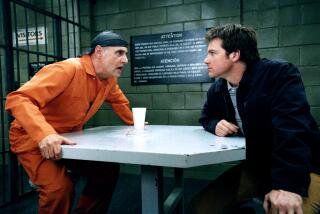‘Mad Men’s’ John Slattery, Matthew Weiner talk Roger Sterling
- Share via
The last time viewers caught a glimpse of Roger Sterling, the rakishly charming advertising executive played by John Slattery on “Mad Men,” he stood naked looking out a hotel window, arms raised in a state of LSD-induced bliss.
The image of Roger’s bare rear end brought a note of levity to a season that was otherwise exceptionally gloomy, even by the brooding standards of “Mad Men,” which returns to AMC Sunday. In addition to the usual mix of ennui and infidelity, the specter of death loomed over the series last year, culminating with the suicide of agency partner Lane Pryce in the penultimate episode.
Things were so grim that even the typically irrepressible Roger was feeling a little out of sorts. Marginalized at the office, barely on speaking terms with former mistress (and mother to his secret love child) Joan, and openly resentful of his trophy wife Jane, he shocked fans halfway through the season by becoming the first character to drop acid on “Mad Men.”
PHOTOS: On the set of ‘Mad Men’
Although it was done on a whim at an otherwise tedious dinner party, the trip was a powerful catalyst for Roger. While under the influence, he and Jane peacefully decided to end their marriage.
“I think he’s had a resurgence kind of across the board in life,” says Slattery, 50, of his character. “He’s had this inadvertent acid trip and I think realized it was too soon to give up.”
Until that fateful moment, Roger had lived a happily unexamined existence, preferring vodka martinis and sly bon mots to psychedelic drugs and soul-searching. An entitled WASP who inherited his high-powered job, Roger is the very embodiment of the status quo, making it seem unlikely he’d tune in, turn on and drop out.
But according to series creator Matthew Weiner, it was a natural progression for the “curious, lighthearted” Roger, even if the wisdom he gained was limited to the kinds of things “most of us have known since we were born.”
The hallucinogenic experience and its aftermath, which included a dalliance with Don Draper’s stunning mother-in-law, only solidified Roger’s status as a fan favorite.
RELATED: ‘Mad Men’ remains set in its artful ways
It seems he can do no wrong, whether he’s performing in blackface, vomiting in the lobby, or covering up the loss of the agency’s biggest client. Roger’s skillfully delivered one-liners have inspired countless supercut montages around the Web (“When God closes a door, he opens a dress”) and even a book, “Sterling’s Gold.” Meanwhile, with his prematurely gray hair, Slattery has become something of a heartthrob — the epitome of the silver fox.
Weiner attributes Roger’s enduring popularity to Slattery’s skills as a performer, pointing to an early “Mad Men” episode, “Long Weekend,” in which he gets frisky with a young woman and remarks on her similarities to his own daughter, somehow without seeming like a creep.
“I don’t know how he turns those corners. That’s a great place for someone in my position to be,” Weiner says, “because I know it’s actually going to be better than I imagined it. Roger decides what he’s going to do, and I know John will find a way for Roger to do it.”
Until “Mad Men,” Slattery was best known for a guest role as a politician with a colorful sexual fetish on “Sex and the City.” Weiner thought of him for Roger after seeing him in the Broadway play “Rabbit Hole.”
But Slattery, who initially auditioned to play Don Draper, was nervous about the long-term commitment of a television series.
PHOTOS: On the set of ‘Mad Men’
“I’ve been in the position where you start something and you’re promised a whole range of things and it doesn’t turn out, so I was leery,” he recalls. “Matt said, ‘I promise you this would be a great part.’ And that was all I had to hear. He’s been at least as good as his word.”
It turned out to be a wise decision. “Mad Men” has earned Slattery four Emmy nominations, the opportunity to act opposite his real-life wife, Talia Balsam (who plays his ex, Mona, on the show) and countless free drinks from fans.
The show has also provided a safe haven for Slattery to at last try his hand at directing. “I’ve been standing around on sets for a long time and I’m never really short on opinion, as my friends and family will tell you,” he says. “It wasn’t until I got here that I thought if this thing sticks around, it would be a good place to give a try if they let me.”
Slattery had to shadow regular series director Phil Abraham several times before Weiner would give him the keys, so to speak. He’s now got five episodes under his belt, including last year’s memorable “Signal 30” — a.k.a. The One Where Lane Punched Pete in the Face.
Though Slattery modestly insists the cast and crew are all so capable that “you could really be asleep most days and you probably couldn’t tell the difference,” his costar Christina Hendricks is more complimentary: “He gives really great notes. And he knows us as people, how to talk to us, how to get something from us, and get something across. It makes things very easy.”
Slattery has also written a feature film he hopes to direct sometime after wrapping production on this season of “Mad Men,” but he’s mum about further details.
In the season ahead, Roger will — spoiler alert — once again be fully clothed. But his voyage of self-discovery is likely to continue, particularly as the series plunges further ahead into the most tumultuous period in recent American history.
Last season ended in the spring of 1967, making it likely that at least some of the new season will incorporate events from 1968, the year that brought the Tet Offensive, the assassinations of Martin Luther King Jr. and Bobby Kennedy, violence at the Democratic National Convention and the election of Richard Nixon.
For a show that often uses the rich history of the decade to illuminate the personal struggles of its characters — JFK’s death provided the impetus for Betty Draper to finally leave her miserable marriage — that’s a whole lot of potential material.
“Things are definitely heating up,” allows the infamously spoiler-phobic Weiner. But “Mad Men” obsessives shouldn’t interpret that to mean Roger will show up, “Forrest Gump”-style, in the kitchen of the Ambassador Hotel.
The guiding theme of the season, says Weiner, is that “there’s a certain point in your life where you end up in a place where you’ve been before and you start to realize maybe you are the problem.”
In other words, Roger’s going to have a lot more to worry about than running low on Stoli.
PHOTOS, VIDEOS & MORE:
PHOTOS: Behind the scenes of ‘Downton Abbey’
VIDEO: Winter TV preview
PHOTOS: Violence in TV shows
More to Read
The complete guide to home viewing
Get Screen Gab for everything about the TV shows and streaming movies everyone’s talking about.
You may occasionally receive promotional content from the Los Angeles Times.






